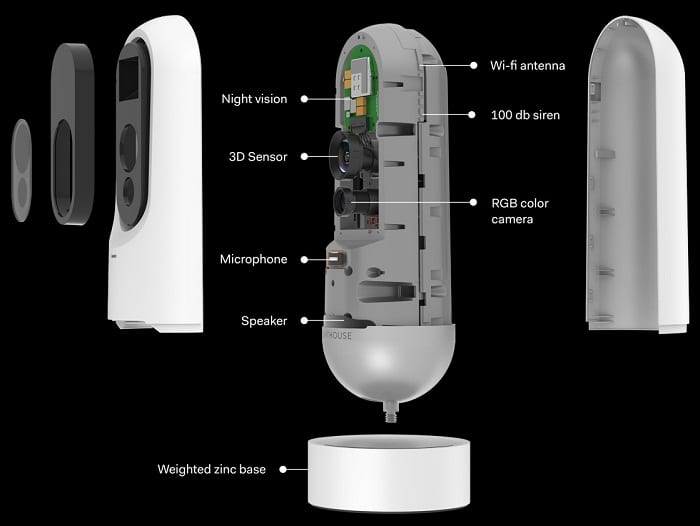Back in May 2017, Lighthouse, a startup backed by Android co-founder Andy Rubin’s Playground Ventures fund, had unveiled its first product: the Lighthouse security camera. Branded as an “interactive assistant” by the company, the device, aimed to take on Amazon or Google-owned Nest security cameras, is now available to buy for the general public.
Lighthouse Security Camera
The device, much like similar products from Nest or Amazon, sits in the home to monitor what’s going on indoors. However, the brains behind Lighthouse, claim this product has a smarter implementation of the artificial intelligence (AI). Lighthouse incorporates deep learning and 3D-sensing technology to determine who is in the home, where they are inside, and if that’s a normal occurrence or not. The camera can recognize faces, keep track of known faces, and, notably, differentiate between pets and human beings.
As for video feed, the camera captures video in 1080p and has automatic night vision. It records a 24-hour feed and stores it for up to 30 days. It pairs with a companion iOS/Android app over Wi-Fi, to remotely send the video feed and alerts to the user. The camera can also adapt to the series of manual pings you set up in the Lighthouse mobile app. For instance, manual pings like “tell me if you see anyone you don’t recognize when the primary user is out of the house” or “tell me if the kids don’t get home by 5,” prompts the device to send alerts if the need be. These pings can be set using natural language voice commands.
As we said earlier, Lighthouse doesn’t see the product as just a home security camera. Instead, they see it as an “interactive assistant” and they do have a perfectly valid reason to back-up the claim. The camera can indeed respond to your voice commands, like Alexa or Google Assistant, though limited to in-house motion queries. You ask it things like “Did the dog walker come on Wednesday?”, or “What time did the kids get home yesterday?”, and it responds with relevant footage. Now that’s some security camera!
Nest has been tinkering with the intelligent in-house security camera with facial recognition and AI for a while now. But it has been rolling out things ever so slowly. It has treated the growing sophistication and importance of AI as an additional feature on its products. Lighthouse, on the other hand, claims that AI is the foundation of everything it’s doing as a company. And oh! It does require some pretty intense machine learning and computer vision to complete what they’ve started. Fortunately, they do have the talent in their pool. Lighthouse CEO and co-founder Alex Teichman worked for seven years with self-driving-car guru Sebastian Thrun at Stanford, prior to Thrun joining Google. He worked on researching and improving the computer-vision methods that allowed Stanford’s autonomous vehicle prototypes to compete in the landmark DARPA Challenge that helped kickstart the self-driving car revolution.
Teichman’s co-founder Hendrik Dahlkamp was the first engineer at Google X and a winner of DARPA’s self-driving Grand Challenge. He is the man behind the Street View in Google Maps. He sold his street-mapping startup Vutool to Google in 2007, and helped transform it into the Street View. With such an extensive experience working with AI and computer vision, the duo certainly have taken the in-house security camera space to the next level.
The pricing they ended up with, however, is little bit unique. First up, the Lighthouse camera costs you $299. Then comes the companion services: cloud video storage and cloud-assisted AI. The companion services cost you $10 per month. However, you can cough up a one-time fee of $200 up front for lifetime access. That’s a lifetime access at a fee equivalent of 20 months at the month-to-month rate. Lighthouse, however, does offers a free trial of its services for 90 days! Interested in getting one? Click the “Buy Now” link below.



















